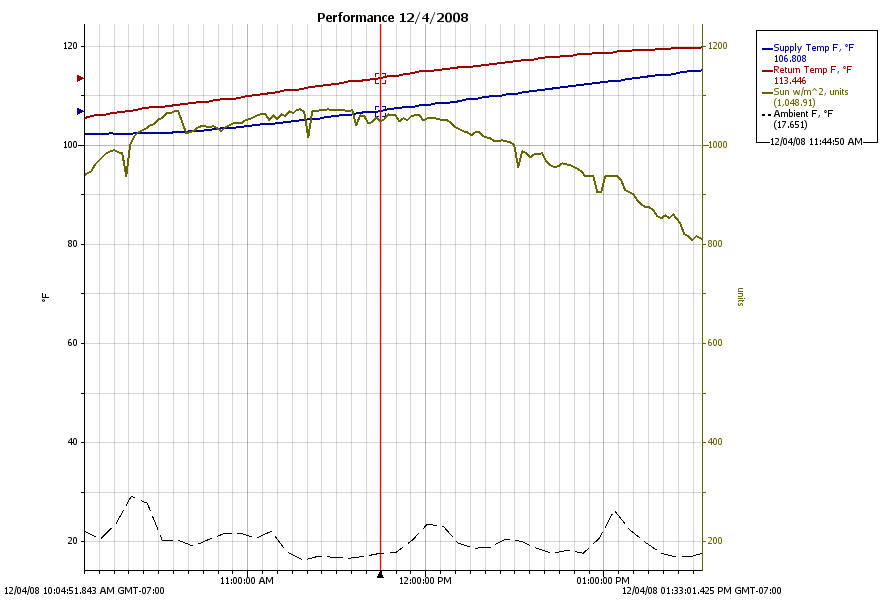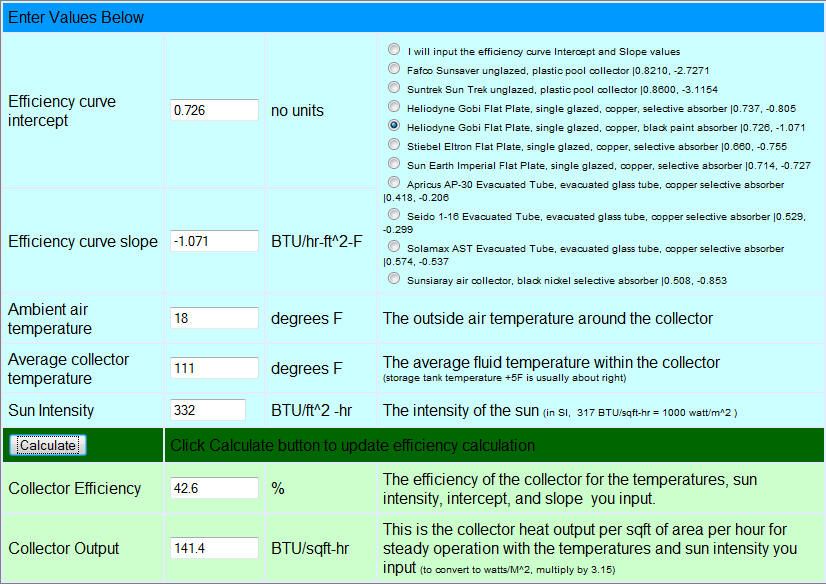
Search
The Renewable Energy site for Do-It-Yourselfers
$1000 Solar Water Heating System
Efficiency Test for December 4, 2008
|
This page uses the data collected
on December 4, 2008 to do a rough estimate of the
PEX Water Heating Collector efficiency.
The results are about as predicted
from the early small panel tests -- the PEX collector shows about
15% less heat output per sqft of collector than a commercial
collector would have under the same conditions, but the PEX
collector's BTU output per dollar of cost is 6.4 times better than
the commercial collector. |
|
The plot below shows the supply and return
water temperatures for the PEX collector for December 4, 2008.
The sun intensity is also shown.
This was a mostly sunny day with occasional
light clouds passing over.
Ambient temp was low (about 18F).

Efficiency
Rough efficiency evaluated at around
11:45 AM.
T supply = 106.8F
T return = 113.5 F
Delta T = (113.5 - 106.8) = 6.7F
Flow rate = 1.73 gpm = 14.4 lb/min =
861.5 lb/hr
Sun = 1049 watts/m^2 = 332 BTU/sf-hr
Collector area = 48 sf
T ambient = 62F
Sun Energy in = (48 sf)(332
BTU/sf-hr) = 15936 BTU/hr
Energy Out = (861.5 lb/hr)(6.7F) (1
BTU/lb -F) = 5772 BTU/hr
Efficiency = (Energy Out) / (Energy
In) = (5772 BTU/hr) / (15936 BTU/hr) = 36.2%
Using the
efficiency calculator, a Heliodyne Gobi flat plate collector with black
painted absorber would give 42.6%
efficiency under the same conditions. So, the PEX collector has an output
of 85% of the Heliodyne flat plate collector. Amazingly, this is agrees
almost exactly with the earlier small panel tests -- isn't science wonderful :)
If both of these efficiencies seem on
the low side it is because the ambient temperature is quite low for a mid day
winter temperature. Even in January, the average midday high in Bozeman is
nearly 30F -- this day was 18F. So, think of these as close to worst case
for a sunny day.
BTU per Dollar
If you do the more important
calculation of heat output per dollar of collector cost, it comes out this way:
PEX Collector cost at $4 per sf = (48 sf)($4)
= $192
Commercial collector at $30 per sf =
(48 sf)($30) = $1440
BTU per dollar for PEX = (5772 BTU) /
($192) = 30.1 BTU/$
BTU per dollar for Commercial =
(42.6%)(15936 BTU) / ($1440) = 4.7 BTU/$
So, the PEX collector is 6.4 times
more cost effective.
The same numbers for the
Copper/Aluminum Collector
would be:
Copper/alum collector cost at $6/sf =
$288
Output should be about 96% of the
commercial collector, so (15936)(0.426)(0.96) = 6517 BTU
BTU per dollar for copper/alum =
(6517 BTU) / ($288) = 22.6 BTU/$
So, about 4.8 times better than the
commercial flat plate.
This is the screen copy for the
efficiency calculation for the Heliodyne Flat Plate Collector

Gary December 5, 2008


